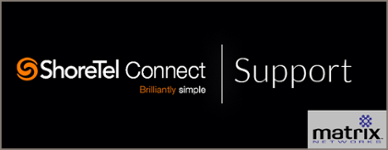
If you read our previous article <Hunt Groups vs WorkGroups>, you may have decided that a hunt group is the best choice for your company's call flow. To refresh your memory, Hunt Groups are primarily used for a group of receptionists or a specifically functioning team, for example, your HR team, where a group of people could conceivably handle any sort of call that comes in and the group has the specific need to handle multiple calls at once.
Hunt Group configurations are handled at the ShoreGear switch level, which can make them ideal for small offices and for larger companies who need to have a basic backup for their contact center or WorkGroup configurations. If your ShoreTel server goes down, but you still have dial tone, you will still have hunt group routing and basic call control.
Distributing Calls to your Employees using ShoreTel Hunt Groups
Hunt groups have two different options that you can choose from to distribute calls to your employees:
- Simultaneous: The ShoreTel system will present the call to everyone in the group – even if they are currently on the phone. This type of setting works best for a group of receptionists.
- Top Down: The calls will be presented based on the rank of the members in the list. In other words, how the employees are listed within the hunt group settings determines how the calls are doled out. Using the Top Down method would be best when you have a certain skill set of people. For example, if one of your employees is fluent in a different language you would want to put them first in line to have the ability to answer those language calls.
Both distribution options are valid, and you do not have to have an "either or" mentality. You can have one hunt group set up as top down and other hunt groups set as simultaneous ring or vice versa. As noted above, certain groups seem to demand one configuration over the other. Your ShoreTel Partner (view Matrix Networks ShoreTel Support Offering) will be able to help you decide which type of hunt group is best for each situation. As a general rule, specialized groups of workers, like Receptionists, Human Resources, Accounting, and the like could benefit from Simultaneous ring because every person on the team is equally able to help any caller.
View all ShoreTel Education
That said, a different sort of specialized team, for example, an IT Help Desk, might want to use Top Down to impose a simplified "tier" system where calls are always hitting certain workers first before being handed to other agents with different skills. Another good reason to use Top Down (beside the language queue example) is for truly specialized situations where you have one or possibly two employees with the skills to handle the calls for that hunt group. You set that employee up in the first position in the hunt group, and other employees in the group are there as backup for that person. The other people in the hunt group are, essentially, a failsafe for the primary employee or employees.
Once you have figured out what routing process you are planning to use, you now need to set the number of rings per group member and a total number of rings for the entire hunt group. When doing this, you will need to be sure to multiply the number of rings by the number of employees to set the correct number of rings for the entire hunt group. If the number of rings doesn’t match the number the ShoreTel will likely send the call to a "no agent" destination prematurely because it will skip over available agents based on faulty math. This might be a great time to have your ShoreTel partner review your hunt group configuration to ensure that you didn't miss a crucial step of the set up.
To ensure you have the total number of rings correct, you will need to multiply the total amount of agents with the number of rings each agent needs. In this example, we will have 4 agents and each phone needs to ring 3 times.
4 X 3 = 12 Total Number of Rings
Like WorkGroups, hunt groups give you the ability to set schedules. However, you are only able to apply schedules for On-hours and Holidays. The hunt groups will only allow you to select one place to send calls when not on-hours. Most times, this will go to an auto attendant that announces your company is closed, or it goes to a specific extension, such as a supervisor or team lead.
Pro-Tech Tip: To maintain your ShoreTel compliance, you are only allowed to have 16 hunt group agents per ShoreTel switch. Having more people than this can cause many issues like ghost calls, faulty call routing, or even a ShoreTel switch failure.
This is because the ShoreTel switch has to use resources to send a hunt group call to every phone in the hunt group every time a call comes into the group. Once someone answers the hunt group call, the other resources are released, but still the resources were temporarily engaged. A good analogy is bridge-building. Every hunt group call that comes in builds a "bridge" to every phone in the hunt group. That's a lot of building material! And while all of those "bridges" are active (I.e. while the hunt group phones are ringing into the group) the ShoreTel switch has extremely limited resources for anything else you might want it to do.
Although, Hunt Groups do not offer as many options to choose from as Workgroups, it still takes some planning and consideration to ensure your calls will be routed properly throughout your company. Hunt Groups can give you the flexibility of multi-answer call groups without the added complexity of a true queuing group.
A Trusted Partner for ShoreTel Support
Knowledge is power. At Matrix, we are dedicated to the continued education of our clients through a variety of mediums including educational articles, video training session, and in-person learning sessions, we call Refresher Courses. If you are a business owner or IT administrator running a ShoreTel Phone System for your organization, I highly recommend you sign up for our Monthly Roll-up so you can stay connected to one of the nation's best ShoreTel Support Providers (humble brag). Until then, enjoy the next article in our ShoreTel education, 3 Keys to a Successful ShoreTel Install.

Author: Daniel Haggard


.svg%20(1).png?width=55&name=1200px-Logo_of_YouTube_(2015-2017).svg%20(1).png)

